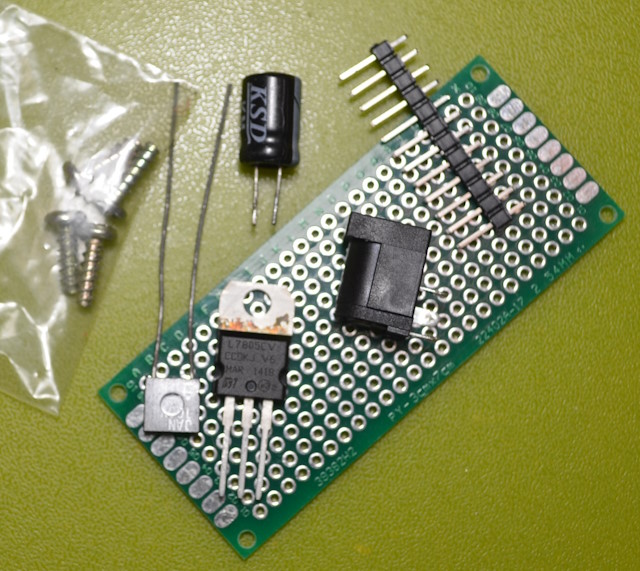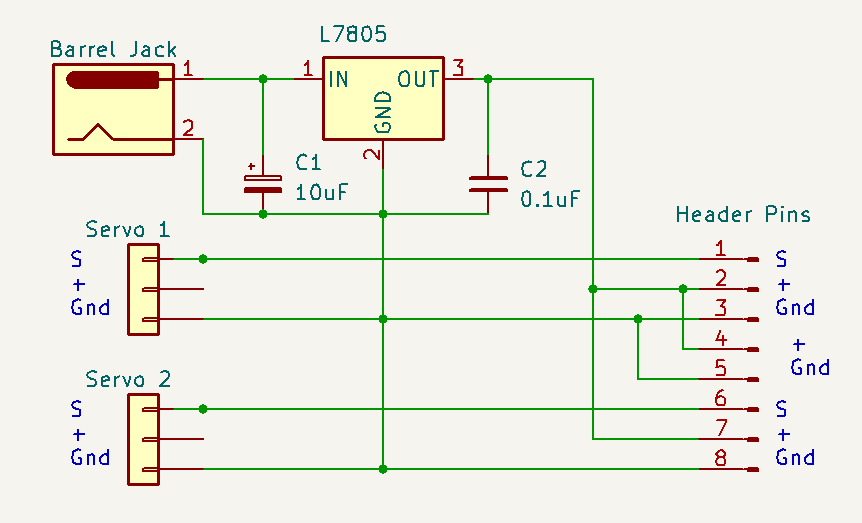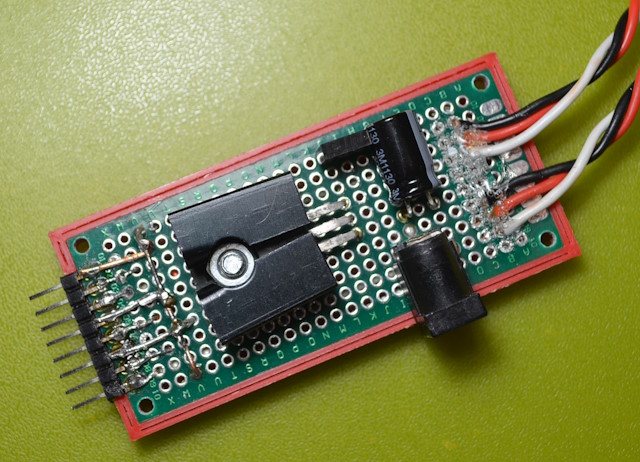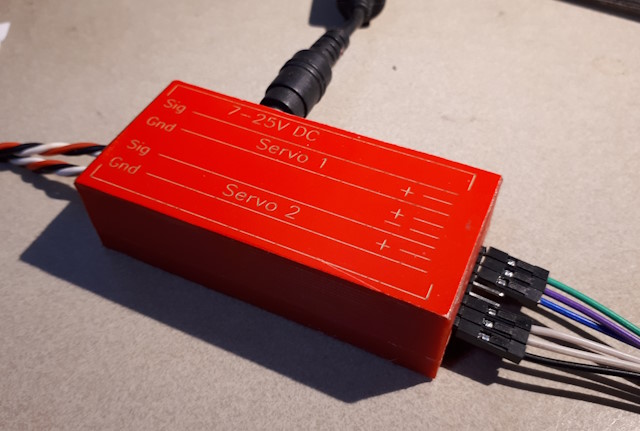Servo Power Booster
A protoboard project that allows a separate 9V (or 9-25V) supply to be
used for powering servos driven from a MCU. A controller such as the
Arduino can create the driver signals for a servo. The servo
requires a 5V supply to operate, but a typical development board, such as
a UNO, does not have sufficient overhead in the 5V supply to reliably
provide the servo power. It can be done, but is not recommended,
especially if the servo is operated under some load. Some
servo/motor shields have no provision for a separate power supply, even if
they support a separate supply for attached DC or stepper motors. To
reliably and safely support servos during project development a unit that
can inject a suitable 5V supply into the servo cable is a useful addition
to the workbench.
Note: Although this project is designed for use with servos, it
works just as well for WS2812 (and similar) LED strips. In that case
the signal is the data for the individual LED colour settings rather than
the servo PWM control, but the principal is exactly the same - the ground
and signal are passed straight through, but the 5V supply is boosted to
~2A (referenced to the common ground) by the external voltage input and
the 5V regulator.
Parts
 Prototyping
board. Any board of a suitable size can be used. This
one is 70mm x 30mm with holes through the centre section and tabs at each
end. The project uses the tabs for easy connection of the servo
flying leads and pin headers.
Prototyping
board. Any board of a suitable size can be used. This
one is 70mm x 30mm with holes through the centre section and tabs at each
end. The project uses the tabs for easy connection of the servo
flying leads and pin headers.
7805 Linear Regulator (5V). The type is not
critical. In this project the regulator was fitted with a heatsink.
Barrel jack (5.5/2.1mm). This size matches the Arduino
and is commonly available with 9V adapters.
Servo cables.
3-wire servo leads with solder tail and 3-pin 0.1" female conenctor.
Capacitors. 10uF electrolytic and 0.1uF ceramic in this
example. The actual values and types depend a lot on the input
source and the expected usage. The 7805 can operate quite happily
without additional capacitors.
8-pin male header. Only 6 pins are actually
required for the servos, but the extra two can be used to provide a 5V/Gnd
output.
3D-printed case with screws to suit.
Label for case (see below).
The device will be powered from any supply capable of providing 9-25V DC.
The regulator is quoted at up to 2A, but the actual rating will depend on
the heatsink and the duty cycle.
An option not considered for this project is to add a USB connection with
the 5V supply wired straight through to the output pins. If this
upgrade is added then a diode would be required to ensure the USB 5V is
not fed back into the 7805 regulator. A switch would achieve a
similar result without the voltage drop.
Construction
 The Circuit layout is quite
simple. The servo signal and ground wires are connected straight
through from the connecting tabs on one end to the header pins at the
other. The servo +5V input is not connected to anything.
The Circuit layout is quite
simple. The servo signal and ground wires are connected straight
through from the connecting tabs on one end to the header pins at the
other. The servo +5V input is not connected to anything.
The barrel jack is wired with a positive pin to the input of the
7805. The 10uF capacitor is wired across the input to ground.
The 7805 ground, the input grounds and the output grounds are all tied
together. The 7805 output is wired to the output +5V headers, with a
0.1uF capacitor to ground.
Additional pins are provided for a spare +5V and Gnd.


This page last updated 18 August 2024

 Prototyping
board. Any board of a suitable size can be used. This
one is 70mm x 30mm with holes through the centre section and tabs at each
end. The project uses the tabs for easy connection of the servo
flying leads and pin headers.
Prototyping
board. Any board of a suitable size can be used. This
one is 70mm x 30mm with holes through the centre section and tabs at each
end. The project uses the tabs for easy connection of the servo
flying leads and pin headers. The Circuit layout is quite
simple. The servo signal and ground wires are connected straight
through from the connecting tabs on one end to the header pins at the
other. The servo +5V input is not connected to anything.
The Circuit layout is quite
simple. The servo signal and ground wires are connected straight
through from the connecting tabs on one end to the header pins at the
other. The servo +5V input is not connected to anything.

